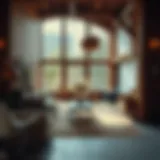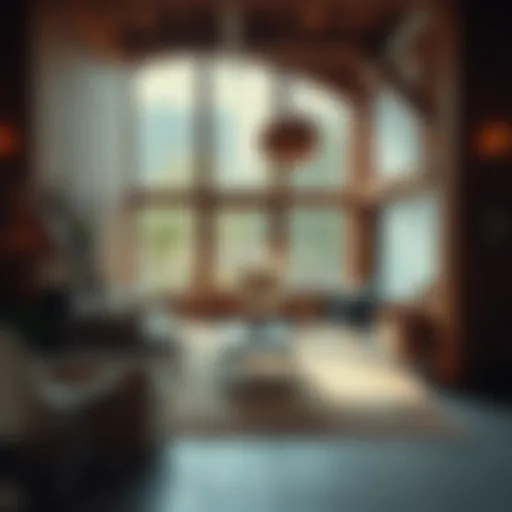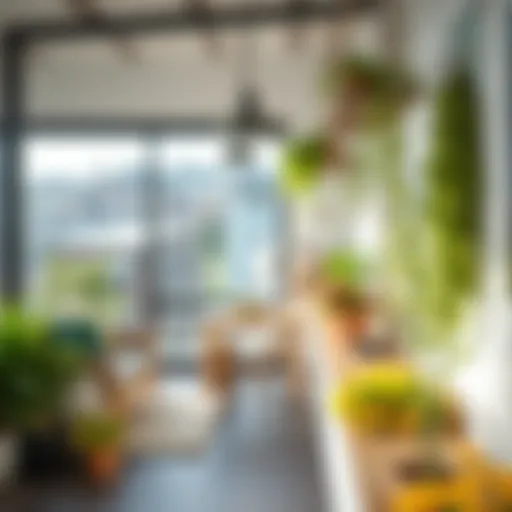The Impact of Skirting Boards on Interior Design


Intro
Skirting boards, often overlooked, have significant importance in interior design. These architectural features serve both practical and aesthetic purposes. They bridge the gap between the wall and the floor, providing a seamless transition that enhances a room's visual appeal. Beyond this, skirting boards also protect walls from scuffs and dirt, contributing to the longevity of interior surfaces.
Understanding the role of skirting boards helps in making informed choices during the design process. Their styles, materials, and installation techniques vary widely, allowing for customization in various settings. As we delve deeper into the intricacies of skirting boards, we will explore essential aspects every designer, builder, and DIY enthusiast should consider.
Foreword to Skirting Boards
Skirting boards, often overlooked in design discussions, play a vital role in interior aesthetics and functionality. They not only cover joints between walls and floors but also serve to protect walls from damage. In this section, we will delve into the definition and purpose of skirting boards, as well as explore their historical context. This understanding lays the groundwork for appreciating their significance in modern interior design.
Definition and Purpose
Skirting boards, also known as baseboards, are typically horizontal boards that run along the lower part of an interior wall. Their primary purpose is to conceal the joint where the wall meets the floor, which can often be unsightly. However, their function extends beyond mere aesthetics.
- Protection: Skirting boards shield the wall from scuffs, scratches, and damage caused by furniture or foot traffic. This is particularly valuable in high-traffic areas like hallways or living rooms.
- Concealing Gaps: They effectively hide expansion gaps that may occur between flooring materials, allowing for movement as humidity and temperature vary. This consideration is essential for maintaining the integrity of flooring.
- Visual Enhancement: From a design perspective, skirting boards enhance a room's overall look. They can complement the room's decor, adding elegance or a modern touch depending on the style chosen.
In summary, the definition of skirting boards encapsulates their dual role of practical protection and aesthetic enhancement, making them a key element in interior design.
Historical Context
The use of skirting boards has a rich history that reflects changes in architectural styles and interior design trends. Originally, skirting boards were a means to hide the imperfections of early construction, evolving from simpler forms to more ornate styles as building techniques improved.
- Renaissance Era: In the Renaissance period, skirting boards, often elaborately carved, reflected the wealth and status of homeowners. They were commonly made from expensive woods and featured intricate designs.
- Victorian Influence: The Victorian era saw advancements in manufacturing, allowing more complex profiles and finishes. Baseboards became a standard feature in homes, with various styles showcasing the homeowner's personal taste.
- Modern Times: Today, skirting boards come in a variety of materials and designs, from sleek, modern lines to traditional profiles. This evolution indicates their adaptability to changing trends in interior design while still serving their essential functions.
Understanding the historical context of skirting boards provides insight into their enduring presence in interior space design, marking them as a vital component throughout the ages.
Materials for Skirting Boards
Skirting boards are more than just a decorative element in a room; they serve a practical purpose too. Materials used for skirting boards can greatly influence the overall style and functionality of a home. Choosing the right material is important, as it can affect durability, ease of installation, and maintenance. Below, we explore various materials for skirting boards, examining their unique benefits and characteristics.
Wood
Wood is one of the most traditional materials for skirting boards. Its natural beauty adds warmth and character to any space. Various wood types can be used, such as oak, pine, or walnut. Each type offers a different grain pattern and level of hardness.
One advantage of wood skirting boards is their durability. If properly finished, they can withstand wear over time. However, they might require regular maintenance. This includes sanding and refinishing to prevent scratches or signs of wear.
Furthermore, wood enables effortless customization. You can easily paint or stain to match your room’s decor. This versatility makes wood a favored choice among many designers.
MDF (Medium-Density Fiberboard)
MDF is a popular option for skirting boards, especially for people looking for an affordable and versatile material. It is made from wood fibers combined with resin, resulting in a smooth surface that is easy to paint.
A major benefit of MDF is its consistency. Unlike natural wood, it does not warp or crack. This makes it suitable for various environments, including those with changes in humidity. Additionally, MDF is less expensive than solid wood, making it appealing for home projects on a budget.
However, MDF skirting boards can be less durable when exposed to water. If water damage occurs, the edges often swell. Hence, ensuring proper installation and sealing is essential for longevity.
PVC and Vinyl
PVC and vinyl materials offer another innovative option for skirting boards. These materials are highly resistant to moisture and can stand up well in areas prone to dampness, such as bathrooms. Because they don't absorb water, they maintain their appearance over time.
A significant advantage of PVC and vinyl is their ease of maintenance. Cleaning is straightforward; a simple wipe with a damp cloth is usually enough. They come in various styles and colors, allowing for great versatility.
However, their durability can be a consideration. PVC skirting boards can dent or scratch more easily than wood or metal. For heavily trafficked areas, careful consideration is required to avoid premature wear.
Metal Options
Metal skirting boards, often made from aluminum or steel, offer a unique and modern aesthetic. They work well in contemporary designs or industrial settings. Metal skirting boards also provide excellent durability and are resistant to impacts and moisture.
One of the benefits of metal is its longevity. They can withstand significant wear without showing damage, making them advantageous for high-traffic areas. Additionally, they are easy to clean and maintain, requiring only occasional wiping to restore their shine.
However, installation can be more complex compared to traditional materials. Some technical skills might be required to achieve the clean look people generally desire in metal designs. Nevertheless, for those embracing a modern approach, metal skirting boards provide an exceptional option that combines both style and practicality.
Styles of Skirting Boards
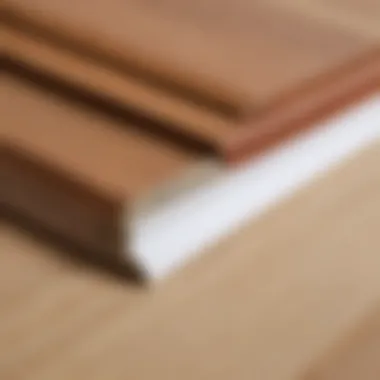

When it comes to interior design, the style of skirting boards can greatly influence the overall look and feel of a room. Understanding the various styles available allows homeowners and designers to make informed choices that align with the desired aesthetic of the space. Skirting boards, often taken for granted, play a crucial role in tying together different elements of a room. Choosing the right style can enhance both the functionality and beauty of an interior.
Traditional Designs
Traditional skirting boards often showcase intricate profiles and detailed craftsmanship. These designs can evoke a sense of elegance and timelessness, making them suitable for classical or historical interiors. Common materials include solid wood, which allows for carving and elegance in the profiles.
The benefits of traditional designs lie not only in their aesthetic appeal but also in their ability to create harmony with vintage or antique furniture.
- Characteristics: Simple yet detailed curves, chamfered edges, and sometimes even decorative motifs are common.
- Applications: Best suited for homes designed in Victorian, Georgian, or similar architectural styles.
Furthermore, traditional skirting boards can complement architraves and ceiling molding, creating a unified decorative scheme inside the home.
Modern Minimalism
Modern minimalism embraces clean lines and simplicity, often rejecting ornate detailing. Skirting boards in this style are generally low-profile and made from materials such as MDF or PVC. Their aim is to blend seamlessly into the wall, enhancing the minimalist aesthetic of the room.
Utilizing monochromatic colors is a typical approach with modern skirting boards, as it helps to maintain an uncluttered look.
- Characteristics: Straight edges, smooth surfaces, and a lack of ornamentation define this style.
- Applications: Ideal for contemporary spaces, lofts, and modern apartments.
Mainly, this style emphasizes the use of negative space, drawing attention to other design elements in the room, such as furniture or artwork. This means that choosing modern minimalist skirting boards can help create a serene and spacious atmosphere within a home.
Contemporary Approaches
Contemporary skirting board styles often merge elements from different design philosophies while focusing on functionality. These might include a mix of traditional detailing with modern materials or finishes. Such flexibility allows for creativity in how skirting boards can be used to enhance interiors.
The appeal of contemporary skirting boards lies in their versatility. They can suit a broad range of decor.
- Characteristics: Combination of textures and materials, including painted finishes with wood grain patterns or even metallic accents.
- Applications: Suitable for urban homes, eclectic designs, and transitional spaces that combine various design styles.
As interior design continues to evolve, so does the role of skirting boards. New innovations and choices allow for more personalized combinations, enabling designers to create unique spaces that reflect individual tastes. Ultimately, selecting the appropriate skirting board style contributes to a cohesive design narrative.
Functional Benefits of Skirting Boards
Understanding the functional benefits of skirting boards is crucial for anyone involved in interior design or renovation. Skirting boards serve multiple purposes that extend beyond mere aesthetics. Their practical applications can significantly enhance the durability of walls and the overall appearance of a room.
Protection for Walls
One of the primary roles of skirting boards is to protect walls from damage. Without these boards, any furniture or objects placed against the wall could easily cause scratches, dents, or stains. Skirting boards act as a barrier, absorbing the impact from these items. In high-traffic areas, such as hallways or living rooms, walls are more vulnerable to wear and tear. By incorporating skirting boards, property owners can prolong the life of their walls and reduce the need for repairs. This protective function is especially vital in homes with children or pets, where accidents are more common. Not to mention, skirting boards can also help prevent moisture from seeping into the walls, which can lead to mold and structural issues over time.
Covers Expansion Gaps
Another significant advantage of skirting boards is their ability to cover expansion gaps. In most homes, flooring materials such as wood or laminate tend to expand or contract with changes in temperature and humidity. These expansions can create unsightly gaps between the flooring and the wall, which may be perceived as a design flaw. Skirting boards offer an effective solution by concealing these gaps. By selecting appropriately sized skirting boards, the aesthetic continuity of a room is maintained while accommodating the natural movements of the flooring. This can be particularly important when dealing with engineered wood or other materials that are sensitive to environmental changes.
Improves Aesthetic Continuity
Beyond the protective and functional responsibilities, skirting boards play a significant role in enhancing a space's visual appeal. They contribute to the overall design language of the interior. Skirting boards can create a clean transition between the walls and floors, establishing a finished look. Depending on the style of the home, the choice of skirting board can complement or contrast with other design elements.
For instance, in a minimalist setting, simple and sleek skirting boards can reinforce a clean aesthetic. Conversely, in traditional interiors, ornate skirting can add character and richness to the space. The height and profile of skirting boards also can vary, providing homeowners and designers with numerous options to customize spaces based on their aesthetic preferences. Ultimately, the inclusion of skirting boards not only protects and conceals but also contributes significantly to the cohesive and inviting nature of interior environments.
"Skirting boards are more than just a decorative border; they are essential for protecting walls, covering gaps, and enhancing aesthetics in any interior design."
Choosing the Right Skirting Board
Choosing the right skirting board is a crucial element in any interior design project. Skirting boards serve not only a decorative purpose but also have functional benefits. They bridge the gap between the wall and the floor, providing protection while completing the overall aesthetic of the space. This section explores important aspects of selecting the appropriate skirting board, focusing on how it ties together various design elements while fitting within practical considerations.
Assessing Room Dimensions
First, it is essential to assess room dimensions before making a decision on skirting boards. The height and size of the room dictate how tall the skirting board should be. In rooms with high ceilings, taller skirting boards are often visually appealing, as they complement the elongated space. Conversely, in smaller rooms, very wide or high skirting boards can make the space feel cramped. Generally, a good measure is for the skirting board height to be around one tenth of the ceiling height. This creates a balanced look. Moreover, skirting boards of various widths can influence the perception of space; wider boards tend to reflect a classical style while narrower boards coordinate with modern themes.
Matching with Interior Style
Another vital consideration in choosing skirting boards is matching them with the interior style of the home. The design should be in harmony with existing architectural details. For traditional spaces, ornate or detailed skirting boards work well, characterized by curves or classic profiles. A room decorated in a modern style typically benefits from simple, straight lines and minimal detailing. One common style in contemporary design is the use of flat skirting boards, which contribute to a seamless and understated finish. Additionally, it is important to remember that skirting boards can also act as a transition between different areas of the home, guiding the eye and maintaining a cohesive theme throughout.
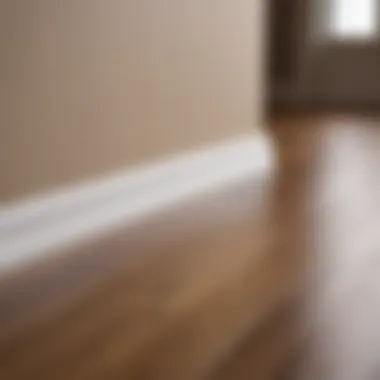

Color and Finish Considerations
Color and finish selections should align with both the skirting board's material and the surrounding environment. A bold color can create drama and impact, especially in neutral rooms. Light colors can offer a clean and airy feel, while darker shades may establish depth and warmth. One should consider how the chosen color interacts with walls, floors, and furniture. Besides color, the finish of the skirting board plays a significant role in its overall appearance. Glossy finishes reflect light and can make a space feel more modern, while matte finishes bring a softer and more traditional touch. Choosing high-quality paint and proper sealing is also critical for durability and maintenance.
"The right skirting board not only enhances the beauty of a space but also serves several functional roles, making its selection a vital part of interior design."
In summary, selecting the right skirting board involves a careful analysis of room dimensions, alignment with interior styles, and consideration of color and finish. By combining these elements, one can create an aesthetically pleasing and cohesive design that adds value to any space.
Installation Techniques
Understanding proper installation techniques for skirting boards is crucial because it determines both the longevity and the effectiveness of their function. Not only do well-installed skirting boards create a seamless transition between wall and floor, but they also enhance the overall appearance of the room. While the design and material choices are significant, poor installation can undermine these advantages.
Preparing the Walls
Preparing the walls is the first key step in the installation process. A smooth, clean surface ensures that the adhesive or any fasteners used will bond effectively. Here are some considerations:
- Inspect the Wall: Check for any damages, such as cracks or holes. These issues may need to be repaired before the skirting boards are installed.
- Clean Surface: Dust, dirt, or grease can affect adhesion. Wipe down the area where the skirting board will be affixed, ensuring it is free from debris.
- Level the Surface: For uneven walls, it may be necessary to use shims to create a uniform surface for the skirting board to rest against. This step is often overlooked, but it can make a significant difference in the final look.
Tools and Materials Needed
Gathering the right tools and materials beforehand is essential for efficiency and effectiveness. Forgetting a tool can slow down the installation process and create frustration. Here are common tools and materials needed:
- Materials:
- Tools:
- Skirting boards of your choice
- Adhesive or fasteners (like nails or screws)
- Wood filler (for gaps or nail holes)
- Caulk (to fill any seams)
- Measuring tape
- Miter saw (to cut boards at an angle)
- Level
- Hammer or nail gun
- Caulk gun
- Utility knife (for cleaning edges)
By preparing adequately, the installation process becomes smoother and more efficient.
Step-by-Step Installation Process
The final segment in this section is about executing the installation. Following a step-by-step process not only streamlines efforts but also helps to achieve a professional finish. Here is a straightforward outline:
- Measure Lengths: Take measurements where the skirting boards will be installed. Add a little extra for cuts.
- Cut to Size: Using the miter saw, cut the skirting boards to the required lengths. Ensure that cuts are clean and precise for better fitting.
- Dry Fit: Before applying adhesive, place the boards loosely against the wall to ensure they fit correctly. Make adjustments if necessary.
- Apply Adhesive: Apply the adhesive on the back of the skirting board or the wall, depending on your chosen method. If using fasteners, space them evenly.
- Position the Board: Press the skirting board into place, checking with a level for proper alignment.
- Secure: If using screws or nails, secure them in place, ensuring they penetrate into the wall adequately.
- Fill Gaps: After placing all boards, use caulk or wood filler to fill any gaps or holes for a more polished look.
- Finish Up: Clean any excess adhesive or filler, and allow everything to dry as per the manufacturer's instructions.
Following these detailed steps will yield satisfying results and maintain the structural integrity of the skirting boards.
“A well-installed skirting board is more than a finishing touch; it plays a vital role in protecting walls and enhancing the room's aesthetic.”
These installation techniques establish a strong foundation, allowing skirting boards to fulfill their crucial role in interior design.
DIY Skirting Board Projects
DIY projects involving skirting boards hold significant value in interior design. They allow individuals to personalize their spaces according to specific tastes and needs. By engaging in these projects, not only does one get to enhance their home's aesthetic appeal, but they also develop practical skills that can be useful in future renovations.
When determining to take on a DIY skirting board project, consider the myriad of benefits. For one, customization options abound. Choosing shapes, styles, and colors can reflect personal style. Furthermore, these projects can lead to cost savings. Hiring professional installers may be expensive; a DIY approach can drastically reduce labor costs.
Moreover, there is satisfaction in crafting something oneself. The process can foster creativity and provide a sense of accomplishment upon completion. As one works on these projects, it is possible to learn about materials and tools, enhancing one’s home improvement skill set. It is this blend of utility and satisfaction that makes DIY skirting board projects an excellent avenue for many.
Customizing Your Skirting Boards
A major component of DIY skirting board projects is customizing them to fit the unique character of your space. Customization starts from selecting material types to deciding on the design. The choice of material impacts both durability and appearance. For example, solid wood offers a classic look, while MDF provides a smoother surface that can be easily painted or finished.
In terms of design, skirting boards can vary widely. Consider the following design choices:
- Height: Taller boards can make a room feel grander, while shorter options can yield a cozy ambiance.
- Profile: Choosing between simple straight edges or more ornate profiles like bullnose or chamfer can change the room's character completely.
- Color: A color that contrasts with wall paint can create a striking effect, while a color that matches the wall can lend a sense of integration.
Customization is about more than just looks. It’s essential to think about functionality, as well. Will the skirting boards need to withstand wear and tear, especially in high-traffic areas? This will inform the choice of material as well as the height and thickness of the boards.
Painting and Finishing Tips
Successfully painting and finishing skirting boards can elevate both their aesthetic and longevity. Proper preparation is critical before applying paint. Ensure the surface is clean and free of dust, dirt, or old paint remnants. Sanding the boards lightly will also help the new paint adhere better.


Here are key tips for achieving a flawless finish:
- Choose the Right Paint: Using a paint specifically designed for wood will ensure durability and ease of cleaning. Satin or semi-gloss finishes are often recommended for skirting boards since they can withstand scuffs.
- Use Quality Brushes: Investing in good-quality brushes or rollers can make a substantial difference in the final product. They can help avoid streaks and provide even coverage.
- Apply Multiple Coats: It’s advisable to apply at least two coats of paint. Ensure the first layer dries completely before applying the second.
- Consider Protective Coatings: After painting, applying a clear varnish or sealant can provide an additional layer of protection, especially in homes with children or pets.
Overall, attention to detail in both the customization process and the finishing touches can significantly enhance the appeal and functionality of skirting boards.
"Investing time in DIY skirting board projects merges craft with functionality, empowering you to redefine your living spaces creatively."
Engaging in DIY skirting board tasks not only augments the visual appeal of your home but also reinforces personal style and practicality, making it a rewarding endeavor.
Maintenance and Care
Skirting boards play a crucial role in both safeguarding the walls and contributing to the overall design of a space. Understanding how to maintain and care for them is essential for preserving their functionality and aesthetic appeal. Proper cleaning and timely repairs can extend the life of skirting boards, ensuring they continue to enhance your interior environment efficiently. Regular maintenance not only keeps them looking fresh but also prevents more extensive damage, which can be costly to fix.
Cleaning Skirting Boards
Cleaning skirting boards is a straightforward yet essential task. Dust and dirt can accumulate over time, dulling their finish and making a room look less appealing. Here are some effective tips for cleaning:
- Choose the Right Tools: A microfiber cloth is ideal for dusting. It captures particles without scratching the surface. For deeper cleaning, a soft sponge with a mild soap solution can help.
- Regularity Matters: Establish a cleaning routine. Depending on dust levels, cleaning every week or every few weeks may be necessary. Regular maintenance can prevent build-up, making each cleaning session easier.
- Use Appropriate Products: Avoid harsh chemicals that can damage the finish. Gentle cleaners are effective and will protect the material. For painted boards, ensure the cleaner is suitable.
- Spot Cleaning: Address stains immediately. Quick action helps to prevent staining. A simple damp cloth can often do the trick. If necessary, a suitable stain remover can also be applied, but follow the manufacturer's recommendations.
By keeping skirting boards clean, you maintain their appearance and prolong their life. A well-maintained skirting board enhances the overall aesthetic of the room.
Repairing Damaged Skirting
Over time, skirting boards may suffer from scratches, chips, or dents due to furniture movement or general wear and tear. Prompt repair is key to preserving both function and style. Here are steps to consider for effective repairs:
- Assess the Damage: Determine the extent of the damage. Minor scratches can often be fixed with touch-up paint, while more significant issues may require skirting board replacement.
- Choose Repair Materials: For minor scratches, a wax crayon or wood filler can work well. For painted skirting, touch-up paint can seamlessly blend the repair with the original color.
- Sanding and Refinishing: For deeper damage, sanding may be required. Lightly sand the area, then apply a matching finish or paint. Allow adequate drying time between applications.
- Consider Professional Help: If the damage is extensive or you're unsure how to proceed, hiring a professional can ensure the repair is done correctly and efficiently.
Regular checks for damage and timely repairs can maintain the integrity of skirting boards, prolonging their lifespan and ensuring your interior design remains consistent and appealing. Keeping skirting boards in good condition can transform the overall look of a room.
"A little maintenance can go a long way in preserving the aesthetics of your space."
By understanding the importance of maintenance and care, those engaged in home improvement and interior design can ensure their skirting boards remain functional and visually appealing for years to come.
Innovations in Skirting Board Design
The design of skirting boards has evolved significantly in recent years. Innovations in this area reflect broader trends in interior design. Homeowners and designers are increasingly looking for solutions that combine aesthetics with functionality. New materials, designs, and technology enhance the user experience and address various practical concerns.
Integrating Technology
Smart home technology has begun to permeate numerous aspects of interior design, and skirting boards are no exception. Modern innovations are integrating technology in unique ways. For example, skirting boards can now incorporate built-in wiring channels. This allows for easy installation of electrical outlets without disrupting the overall look of a room.
Additionally, some skirting boards include LED lighting options. This feature can be both functional and aesthetic, providing ambient lighting along the floors. Home automation systems can also be integrated within skirting designs. This allows homeowners to control lighting and other features through their smartphones.
The consistency of these technical advancements allows for an increase in the usability of spaces. Imagine having seamless designs that also hide unsightly cables and wires. The blend of style and function represents a key direction for skirting board design.
Sustainable Materials
Another important trend in skirting board design is the shift towards sustainable materials. There is a growing recognition of environmental issues, and many designers strive to use resources that have minimal ecological impact. This could include recycled materials or responsibly sourced woods.
Bamboo, for instance, is increasingly favored due to its rapid growth and low environmental footprint. Similarly, reclaimed wood is popular as it reduces waste while providing a unique, rustic charm. In terms of synthetic materials, companies are now producing PVC variants that are made from recycled plastics, which also ensure durability and low maintenance.
Beyond just eco-friendliness, sustainable options often contribute to better indoor air quality. Manufacturers are now mindful of the emissions from adhesives and finishes. Products that are low in volatile organic compounds (VOCs) are becoming more readily available, promoting a healthier living environment.
Sustainable choices benefit both the planet and the health of inhabitants.
Finale
Skirting boards play a critical role in interior design, intertwining functionality and aesthetic appeal. Their influence extends beyond being mere decorative trim; they serve essential purposes that enhance the overall aesthetics of spaces. When reflecting on the entire discussion, several key elements emerge.
Recap of Key Points
- Functional Benefits: Skirting boards protect walls from wear and tear, cover unsightly gaps, and provide a polished edge to flooring.
- Material Selection: Various materials like wood, MDF, and PVC contribute unique characteristics to skirting boards, influencing durability, cost, and appearance.
- Styles and Trends: The choice of board style—from traditional designs to modern minimalism—affects how a room feels and functions. Trends evolve, showcasing a shift towards integrating technology and sustainability.
- Installation and Maintenance: Proper installation techniques ensure longevity, while regular maintenance keeps the boards looking their best.
Future Trends in Skirting Board Design
As interior design continues its evolution, one can anticipate a few notable trends in skirting boards. These include:
- Smart Skirting Boards: Integration of technology could lead to skirting boards that incorporate LED lighting or outlets for charging devices.
- Sustainable Options: A growing demand for eco-friendly materials may result in more skirting boards made from recycled or sustainable resources.
- Custom Designs: Personalization is key. Custom designs that match individual style preferences will likely gain popularity.
- Versatile Applications: Expect to see versatile skirting boards that can adapt to different types of flooring and design styles, enhancing cohesive looks across various spaces.
In summary, the relevance of skirting boards cannot be underestimated. Understanding their role can significantly influence not only the functionality but also the overall design of a space.




